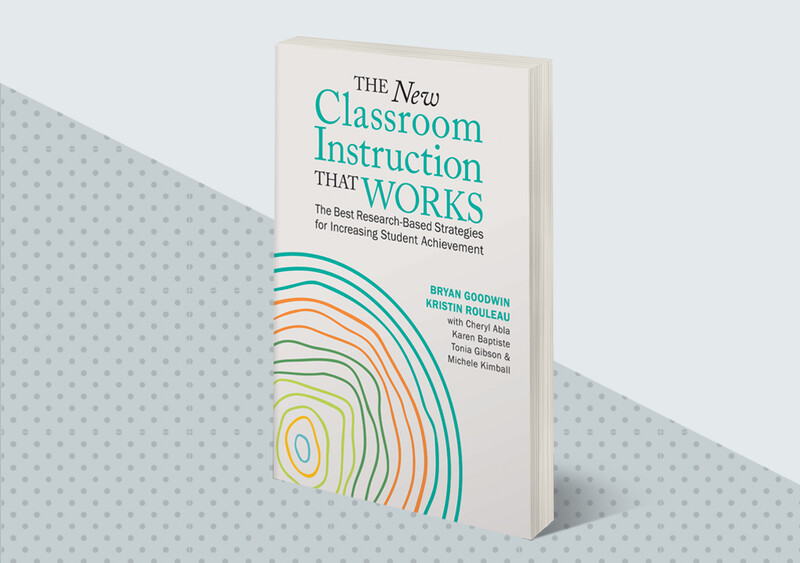When a new edition of a popular book hits the shelves, we’re all prone to wonder: Is it really new? Or is it just a clever way to sell more books?
But there’s a reason we’ve titled the latest edition of our book, which has been ASCD’s most popular title of all time, selling more than one million copies in at least a dozen languages, The New Classroom Instruction That Works: The Best Research-Based Strategies for Increasing Student Achievement.
This book really is new, from top to bottom. In the quarter century since the initial research for the first edition (2001), the research base has grown more robust and sophisticated. Today’s educators have more scientific understanding of how students learn and how to support their learning than at any time in human history.
On top of that, over the past 20 years, the education profession has recognized the moral imperative of ensuring more equitable outcomes for students—and the power of high-quality first instruction to do so. In recent years, we've also heard from educators everywhere that the competing demands on student attention have heightened the need to make what happens in the classroom all the more engaging and relevant.
We had these realities of modern classrooms in mind as we researched and wrote this edition. In short, we recognized that what was needed was not another edition, but a new one.
1. A new research base.
For starters, we took a fresh look at classroom research and only included in our sample studies that reflect rigorous research designs—that rely, for example, on randomly selected treatment and control groups. The vast majority of these studies were conducted in the past 20 years. As a result, no studies from the first edition (2001) and only five studies from the second edition (2012) were among the 105 studies that comprise the new book’s research base. Perhaps most important, nearly three-quarters of the studies in the new edition were conducted in classrooms with diverse learners (where more than 40 percent of students were multilingual, ethnically or culturally diverse, came from low-income households, or were previously low performing), a focus missing from the first two editions.
2. Integrating the science of learning with the science of teaching.
While helping teachers implement the findings of the two previous editions of the book, we observed that even after teachers learned how to use a particular strategy, they often didn’t know why or when to use it. We began to wonder if this might be because not all teachers deeply understand the science of learning—that is, how exactly students convert new information into long-term memory.
Today’s educators have more scientific understanding of how students learn and how to support their learning than at any time in human history.
As it turns out, decades of cognitive science offer compelling insights into the science of learning, yet these insights appear to be infrequently taught in most teacher preparation programs. For example, we’ve long known one of the best ways to help students retain new learning is to quiz (but not grade) them frequently on it (a strategy called retrieval practice). Yet studies of teacher preparation programs find that this and other well-documented science of learning strategies are seldom included in pre-service textbooks or taught in teacher preparation programs. To support teachers in more intentional use of the 14 strategies included in The New Classroom Instruction That Works, we mapped them onto a six-phase model of learning drawn from the science of learning (and reported in a companion book, Learning That Sticks), thereby integrating the science of learning with the science of teaching (see table below).
3. A new set of strategies proven to support equitable outcomes.
The two previous editions of Classroom Instruction That Works identified dozens of teaching strategies and clustered them into nine broad categories. The new edition is more focused, identifying 14 teaching strategies total based on their effect sizes. Because these strategies came from studies conducted in classrooms with diverse learners, they can lift all learners and, in some cases, close achievement gaps almost entirely. We report these effect sizes using a metric from the What Works Clearinghouse called an “improvement index score,” which represents the percentile increase in achievement that students whose teachers use a particular strategy (or combination of strategies) would demonstrate versus students in a business-as-usual classroom.
The studies that support the 14 strategies included in the book have effect sizes that range from 8 to 49 percentile points, which are, incidentally, the equivalent of anywhere from a few months to a year or more of greater learning. Most important, the studies focused solely on students from marginalized groups and/or students who had previously underperformed relative to their peers, meaning these strategies were shown to help these students catch up with, and in some cases, even exceed, the performance of students in the general population.
4. Emphasizing effective and joyful learning.
We sometimes hear teachers say that research-based teaching strategies are overly rigid, didactic, or joyless—leaving little room for teacher creativity or ingenuity. Our experience from working with educators across the globe is that this integration of the science of learning and teaching makes learning more joyful and engaging by providing students with learning experiences that reflect how their brains actually work. What the research we share in this book shows is that great teaching isn’t dry, didactic, or boring. Rather, it engages students in rich, hands-on and minds-on learning experiences that spark their curiosity, fire their imaginations, and reflect their interests—for example, building skateboard ramps to grasp physics, relating history to their personal lives, or seeing their own interests come to life in math problems.
Accordingly, a key aim of The New Classroom Instruction That Works is to prompt teachers to design and deliver learning experiences that make the entire process of teaching and learning easier and more joyful. Indeed, many of the new teaching strategies—such as cognitive interest cues, student goal setting, and guided investigations—increase student achievement precisely because they foster student engagement, curiosity, and the joy of learning.
So, What Hasn’t Changed?
As we were researching and writing this book, all of us here at McREL International were keenly aware that we were standing on the shoulders of many great thinkers and educators—including Robert Marzano, who had the original vision of distilling an overwhelming mass of research studies into a manageable collection of instructional strategies that every teacher could incorporate into their classroom repertoire. That principle of distilling simplicity from complexity animates this book, along with the idea that teaching is a profession. Like medicine or engineering, what we do as educators is based on real science. After all, teaching is akin to performing noninvasive brain surgery on two dozen or more patients at a time—the process of rewiring students’ brains to help them develop and retain new knowledge and skills.
The New Classroom Instruction That Works
A fresh look at the best strategies for creating more equitable student outcomes.









